Introduction: In this article, Melissa Davenport Berry continues exploring a DAR scrapbook created by Mary Louisa Foster (Nash) Power, showing lots of old photos. Melissa is a genealogist who has a website, americana-archives.com, and a Facebook group, New England Family Genealogy and History.
Today I continue with the scrapbook created by Mrs. Mary Louisa Foster (Nash) Power (1862-1947), a member of the Chief Justice Cushing Chapter, National Society Daughters of the American Revolution (DAR).
The scrapbook is housed at the Norwell Historical Society and covers the years 1917 through the late 1930s. You can view a copy of it at Americana-Archives.

To recap: My last post covered the man the chapter was named for: Chief Justice William C. Cushing (1732-1810), who was among the Cushing male lines known as “the family of judges,” and the scrapbook creator Mrs. Mary Louisa Foster (Nash) Power. (See: Part 1.)
Here is a photo of Mrs. Power from a Boston Herald newspaper feature from 1914.
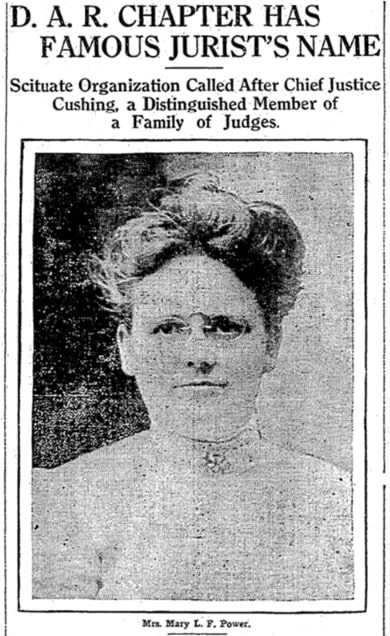
Scituate Lighthouse
The newspaper article mentions that the chapter members were making efforts toward the preservation of Scituate Lighthouse.
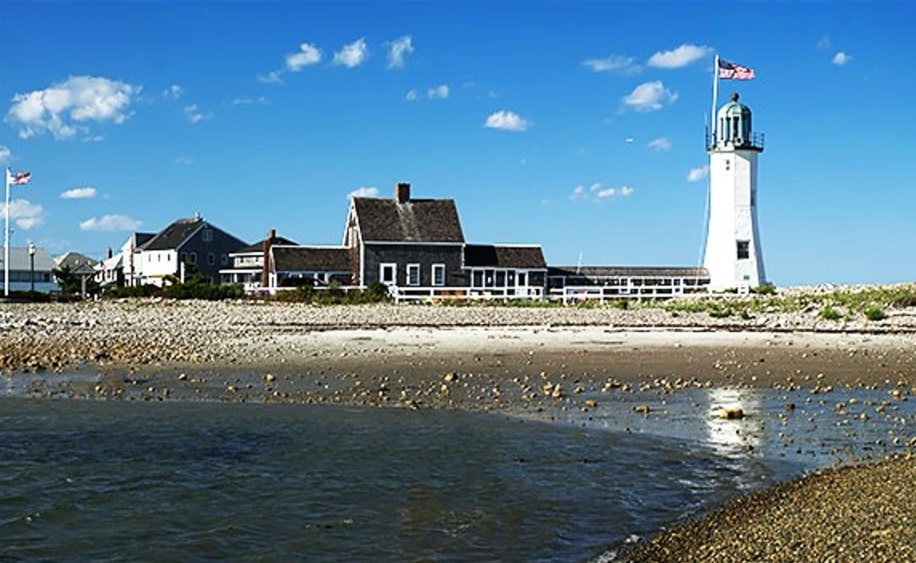
Scituate Lighthouse was the scene of the memorable “Army of Two,” a thrilling story of two brave dames during the War of 1812 who kept the Brits from sacking the town.
The two girls, sisters Rebecca (21) and Abigail (17) Bates, were pictured on the cover of an 1878 edition of Harper’s Weekly.
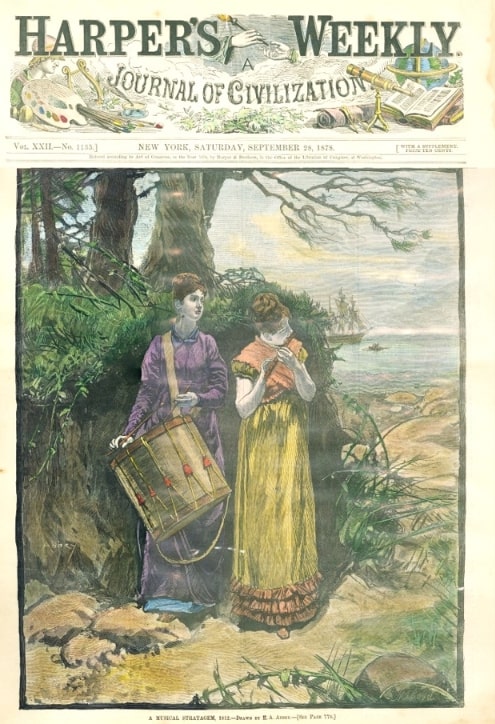
The story is told in the DAR book “Old Scituate” by member Mary Emerson Walbach (1865-1934), born Mary Emerson Welch to Edmund Parker and Mary Lincoln (Collier) Welch. Mary Emerson Welch married George Gorham Walbach.

Mrs. Walbach’s account states the following:
“On September 1, 1814, when guards supposed to be on duty at the lighthouse were absent, the British frigate ‘La Hogue’ appeared off the shore. The ship anchored near the lighthouse, in which, at the time, there was no one but the wife of the first keeper, Capt. Simeon Bates, and his two daughters, Abigail and Rebecca, familiarly known as Nabby and Becky Bates, young girls in their teens [Rebecca was actually 21].
“The guards had left a fife and drum as well as their firearms in the lighthouse. As the family watched the troops [preparing for] a landing, they felt a terrible responsibility upon them and tried to devise some plan to meet the emergency or at least delay their landing until the regular guard should come.
“Placing themselves so as not to be seen from the water, Becky commenced playing ‘Yankee Doodle’ on the fife, and Nabby beat the drum. Two barges packed with British soldiers had left the ship and had covered about halt the distance to the landing when the stirring roll of a drum calling the soldiers to arms and the martial strains of ‘Yankee Doodle’ from a fife rang warlike from behind the lighthouse.
“The boats stopped, the officer in charge considering the forces with him too small to meet the reception he feared was waiting for him on shore. The commander-in-chief, who was watching from the frigate, also became alarmed, and the boats, hastily recalled by the firing of a gun, returned to the ship.’ La Hogue’ hoisted her sails and left the harbor. There had been no guard to receive the attack; the drummer was Nabby and the fifer was Becky.”
A British man-of-war and its force of soldiers had been frightened away by two quick-witted American girls!

Ella Turner Bates
Below is a photo from the scrapbook of the founder of the Chief Justice Cushing Chapter DAR, Ella Turner Bates (1844-1917), daughter of Charles and Clara (Turner) Bates. She was one of the organizers of the Bates Association and a genealogist who prepared a manuscript of the Bates descendants.
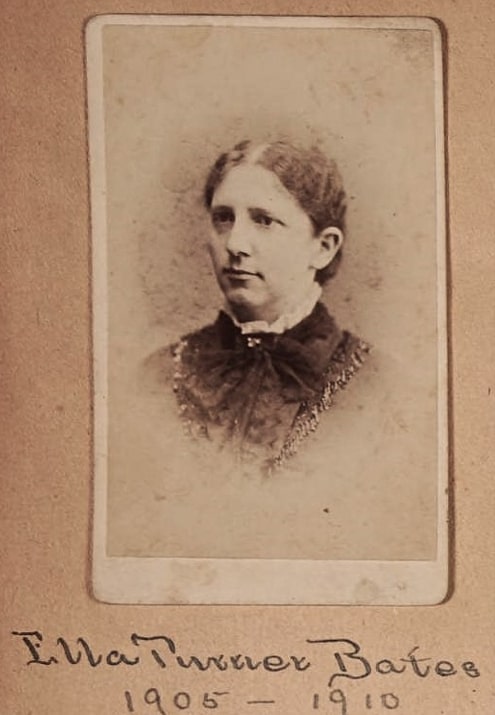
1935 DAR Convention
This photo from the scrapbook features Mrs. William Becker and Mrs. Russell William Magna at a DAR Convention in 1935.
Mrs. William Becker (1886-1971), born Florence A. Hague to Ainsworth James and Susan (Baker) Hague, is the wife of William A. Becker. Mrs. Russell William Magna (1885-1960), was born Edith Scott to Colonel Walter Scott, a businessman and philanthropist for whom the Scott Medal was named, and Sarah Dean (Campbell) Scott. Edith is the wife of Russell William Magna.
There was a major battle between these two daughters of freedom and apparently it became quite a political scandal – even to the point that Mrs. Franklin D. Roosevelt became entangled.
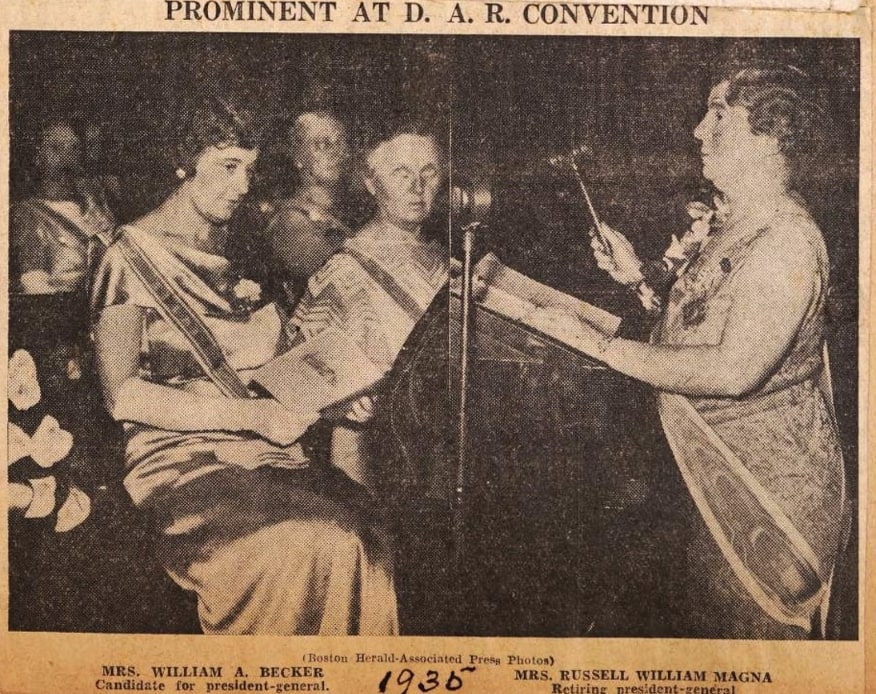
If you want to read the skinny, GenealogyBank’s Historical Newspaper Archives have the whole drama, such as this article entitled “Bitter DAR Issues Draws First Lady.”
I found a photo of the two who seem to have suspended their feud for a photo op.
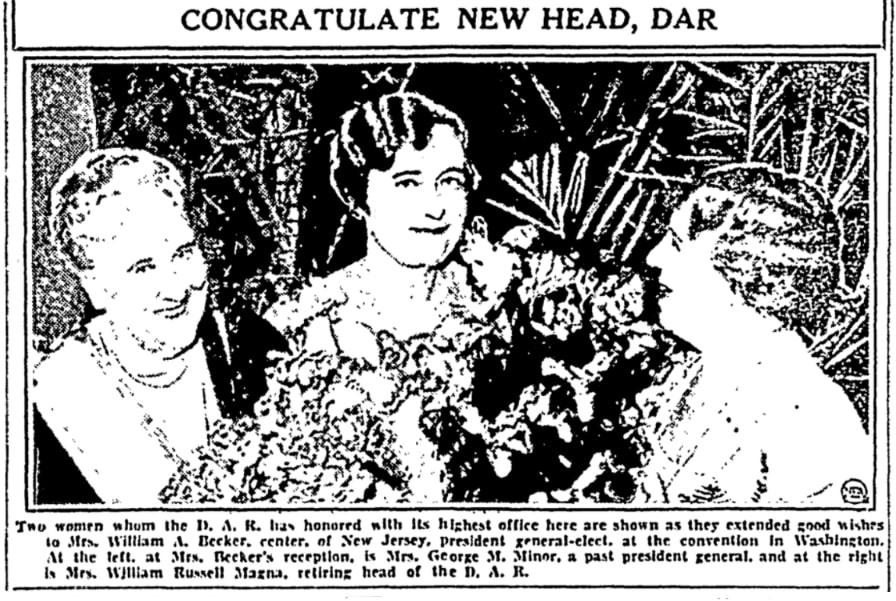
This photo caption reads:
Two women whom the D.A.R. has honored with its highest office here are shown as they extended good wishes to Mrs. William A. Becker, center, of New Jersey, president general-elect, at the convention in Washington. At the left, at Mrs. Becker’s reception, is Mrs. George M. Minor, a past president general, and at the right is Mrs. Russell William Magna, retiring head of the D.A.R.
Mary Josephine (Hatch) Corthell
DAR member Mrs. Mary Josephine (Hatch) Corthell (1877-1936), born Mary Josephine Hatch to Cushing and Abigail (Neale) Hatch, married George Stetson Corthell (1874-1923), son of John Henery and Mercy Collier (Bates) Corthell. Below is her photo from the scrapbook.
Her patriot was Jonathan Hatch (1739-1819), a lieutenant in Captain Joseph Cliff’s Company, Colonel Anthony Thomas’ Plymouth County Regiment of Militia. (“Lineage Book of the Charter Members of the DAR, Volume 51,” 1919.) Mrs. Corthell also descends from Mayflower passenger William Brewster through his son Jonathan Brewster, who married Lucretia “Lucy” Oldham in Plymouth on 10 April 1624.
During her time in the DAR, Mary hosted many of the meetings and contributed to the ongoing preservation of the history of the community.
Stay tuned for more DAR scrapbook shares with Mayflower connections and the monument the chapter erected to honor the Pilgrims…
Explore over 330 years of newspapers and historical records in GenealogyBank. Discover your family story! Start a 7-Day Free Trial
Note on the header image: the Bates sisters on the cover of “Harper’s Weekly,” 1878, illustration by E. A. Abbey. Credit: Scituate Historical Society.
Related Article:
